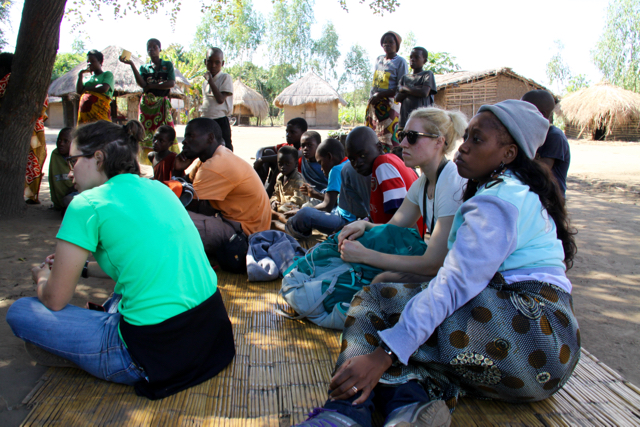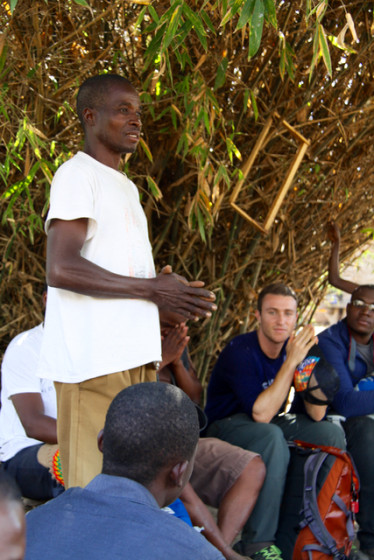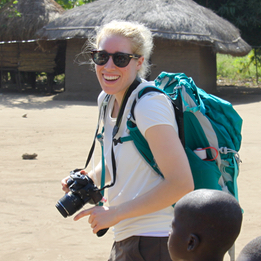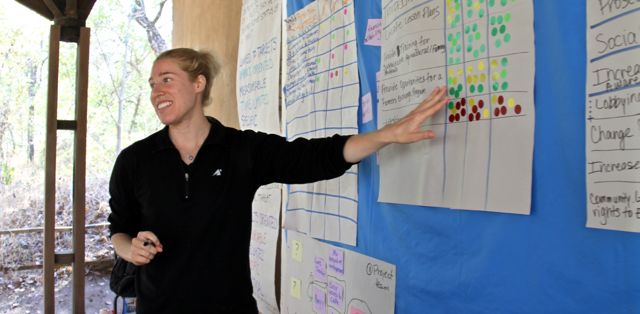After a few days of classroom learning, our Next Gen team hit the road and went for a field visit to Vinho – a community that is just outside Gorongosa National Park’s boundaries in an area they call the buffer zone. As Courtney reflects in this new Next Gen Voice blog, experiencing and observing the practical implementation of so many conservation management and leadership principles started to bring all that classroom learning to life.
Before coming to the Lost Mountain Symposium in Mozambique, I had often assumed that environmental protection rests solely on the efforts to conserve plant and animal species – I hadn’t considered broadening my perception of what we are working to conserve. I hadn’t considered the communities of people. Together, the people and their interaction with the plants, animals and entire ecosystems culminate into an immensely powerful force for conservation.
Yesterday, I had a chance to experience this first hand when the Symposium group went to Vinho— a small community that is just across the river from Gorongosa National Park and exists in what is called the park’s buffer zone. It was an opportunity for me to really see how all of the things we have been learning at The 2015 Lost Mountain Next Gen Symposium – specifically through our training in the Open Standards practices for conservation management. To me, it all came together yesterday.

Sitting on bamboo mats, we were welcomed into a Vinho community meeting to listen to representatives discuss how Gorongosa had found a buyer for Vinho’s crops. Solidifying this partnership with a buyer is an important part of the community’s growth in their agricultural development. It was amazing to see the strength of the relationship between the park and the community through examples like this. 
Acting symbiotically, Gorongosa depends on the surrounding communities’ support to truly thrive.The communal support for Gorongosa and the environmental standards of protection and conservation that the park pursues, enables the park to continue its mission to expand biodiversity in the area and to recover some of the world’s foremost endangered species. In turn, the park has invested in communities like Vinho by building new schools, creating a health clinic and by connecting the community to new markets for them to sell their crops and products.
By conserving and elevating the Vinho community by planting seeds for quality education, health, and financial activity, Gorongsoa National Park has fostered environmental and social growth. Small ripples of this can branch out to create large waves of lasting change throughout any community and area.
For example, by creating schools, the Vinho community now has access to learning that can aid in allowing children to pursue higher education, new career paths away from their dependence on subsistence farming. With better incomes, people can reinvest profits into their families and communities. With more resources available, people could begin to move away from damaging environmental practices that are largely done because of limited options – practices like, slash and burn agriculture and over hunting/fishing. All together, these ripples have a positive environmental impact.
Our visit to the Vinho community showed me that by broadening our definitions, ideas and theories of what it means to “protect the environment”, we can simultaneously empower and elevate communities while making positive, lasting change in the environment as well. It is all connected.
Given that we are halfway through the Symposium, it was the perfect time to visit the Vinho community. To see firsthand the challenges and opportunities we face when practically addressing issues of conservation and how wide the scope of work and impact really is, was invaluable.
As we head into the last few days of the Symposium, we are using everything we have learned and seen to create the next steps of the plan for development, community engagement and conservation for Mount Namuli. It’s all coming together now and I couldn’t be more excited.
 Courtney Fieldman graduated from Princeton University, USA in 2012 with a BA in International Relations and a certificate in Environmental Studies. She was inspired to take part in The 2015 Lost Mountain Next Gen Symposium to learn how best practices from the world of conservation management can be applied to different cultures and communities.
Courtney Fieldman graduated from Princeton University, USA in 2012 with a BA in International Relations and a certificate in Environmental Studies. She was inspired to take part in The 2015 Lost Mountain Next Gen Symposium to learn how best practices from the world of conservation management can be applied to different cultures and communities.
What’s a Next Gen? For us, a Next Gen is any young person who pursues their passions for driving positive change, exploring this great planet, forming new connections, and creating lasting impact. They are students and young professionals working on the hard issues of our time with big dreams about our global future. Read more Next Gen Voice Blogs.

